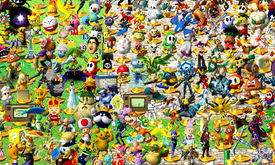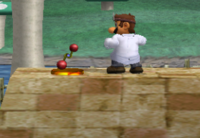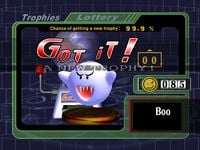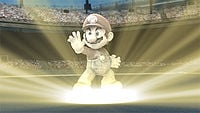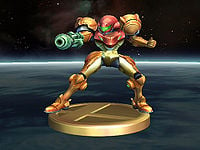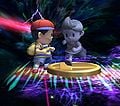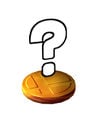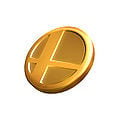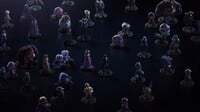Trophy
Trophies (フィギュア, Figure) are collectible items found in Super Smash Bros. Melee, Super Smash Bros. Brawl, and Super Smash Bros. 4.
Trophies represent various characters, items, and other elements from the many games released by Nintendo (and from some third-party franchises, since Brawl). They range from well-known to obscure, including some that were released in Japan only (or were not released until after the Smash Bros. game in question). Collecting them is optional, and does not affect the gameplay of the other modes (excluding the Birdo trophy in Melee only, where obtaining it unlocks a stage).
The backstory of the Super Smash Bros. series from Melee onwards depicts characters as coming to life from trophies (and in Super Smash Bros., plush dolls). While an occasional misconception is that the fighters are living figurines in a literal sense, the implications of this concept demonstrate otherwise and have varied as the series has progressed. In Melee and Brawl, the fighters exist as trophies when dormant or dead and transform into living beings to fight against each other. In Super Smash Bros. Ultimate, trophies do not exist at all within the game (aside from Assist Trophies) and have been stated to merely exist as the fighters' forms in the "real world", whereas the characters exist as living beings in the "world of imagination" in which the game takes place.
In Super Smash Bros.[edit]
Trophies were not present in the original Super Smash Bros. However, two precursors to their debut in Super Smash Bros. Melee can be seen in the game.
In the game's opening sequence, Continue screen, and ending sequence, all characters are depicted as plush dolls that appear to come to life; Melee later introduced on-screen appearances where characters are depicted as trophies that come to life before battles, and Brawl later made this a central plot point in the Subspace Emissary.
Furthermore, Smash 64 includes profiles of the twelve playable characters, with the eight starter characters' profiles available from the start and the remaining four unlocked at the same time as those characters. Similar in presentation to trophies, the model of the character is animated, displaying various attacks, animations and poses for the character, as well as providing names for their special moves. The model can also be rotated by holding the Z button and moving the Control Stick. Later games had most of these features, though these profiles did not include moving models of the subject.
Kirby in his "doll" state on the Continue screen.
In Super Smash Bros. Melee[edit]
Trophies made their first appearance in Super Smash Bros. Melee. There are a total of 290 trophies obtainable through regular play in the NTSC and PAL versions, with three additional trophies only accessible with an Action Replay (see below).
[edit]
From the main menu of SSBM, a Trophies option exists. From here, players can view collected trophies, or gamble to collect new ones.
- The Gallery option allows players to view collected trophies, one at a time. Flavor text describes the trophy, and what its abilities or uses were in its original game, or simply describes the game itself. A box at the bottom-right names the game and year it first appeared in; if the language is set to Japanese, then the system it appeared on first is also displayed. Each of the playable characters has three different trophies: one with general information about them, with models patterned after their home series (obtained upon clearing Classic Mode with that character), and two describing their attacks and gameplay characteristics, each using their in-game model (obtained upon clearing Adventure or All-Star Modes with the respective character), with the most obvious examples can be seen with Peach, Fox, Falco, Marth, and the Ice Climbers. The trophy can be rotated and zoomed, and the background can be changed. When the Gallery is selected, it automatically views the last trophy viewed. If B is pressed after this, a list of collected trophies is shown, which can be arranged in the Normal setting, by Series or in Alphabetical Order. Newly-collected trophies that have not been viewed yet will have a "New!" banner beside them.
- The Trophy Lottery allows players to spend Coins, collected through normal gameplay, to collect new trophies.
- The Collection option allows players to see all the trophies that have been collected.
Collecting trophies[edit]
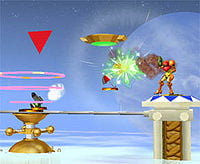
There are several methods in which to collect trophies:
- The player always receives a single random trophy when starting a new game file.
- The 1P Classic Mode contains a bonus stage called "Snag the Trophies". The goal of this mini-game is to knock three falling trophies into a goal in the center of the stage. Any collected trophies are added to the Gallery, and if all three trophies are collected, bonus points are awarded at the end of the game.
- During the Race to the Finish bonus stage, trophies can be found lying around.
- By completing Classic Mode, Adventure Mode or All-Star Mode with a certain character, players can gain trophies of that character. Each mode yields a unique trophy, resulting in 78 unique trophies for the 26 characters (Sheik's trophies are unlocked at the same time as Zelda's).
- In certain Adventure Mode stages, trophies can be found lying around the environment, or by defeating common enemies. These can be picked up like items, and are added to the player's collection.
- In All-Star Mode, trophies can be found after every few rounds.
- Trophies can be collected by completing Event Matches 3, 14, 26, 45 and 47 (Motion-Sensor Bomb, Goomba, Entei, Game & Watch, and Majora's Mask, respectively).
- The Trophy Lottery, as mentioned above, allows the player to collect random trophies in exchange for Coins.
- Completing special tasks within the game will award the player with trophies. For a complete list, see the List of trophies and List of trophies by unlock criteria (SSBM).
Trophy rarity[edit]
On Smabura-Ken, trophies are assigned a rarity value depending on how they are obtained. This rarity value is not visible in-game.[1]
- F (72): Can be obtained in the single-player modes or through the lottery from a fresh file. One trophy of this rarity is awarded immediately upon starting the game.
- E (12): Can be obtained through the lottery from a fresh file.
- D (23): Can be obtained through the lottery after clearing Classic and Adventure at least once, or after obtaining all of the E rarity trophies.
- C (17/16): Can be obtained in the single-player modes or through the lottery after playing 200 matches, or after obtaining all of the D rarity trophies. Tamagon is in this rarity only in the Japanese version.
- B (10): Can be obtained through the lottery after unlocking all characters, or after obtaining all of the C rarity trophies.
- A (4): Can be obtained through the lottery after collecting 250 unique trophies.
- I (27): Can only be obtained in the single-player modes.
- X (126): Can only be obtained through special circumstances. Encompasses the 78 fighter trophies as well as 48 unique trophies.
- S (2): Can only be obtained through special events (the Mario & Yoshi and Samus Unmasked trophies).
Changes between versions[edit]
- In the Japanese version, the Motion-Sensor Bomb was designed after the Proximity Mine from Perfect Dark. However, in the North American and PAL versions, the item's appearance was changed to that of a weapon from GoldenEye 007 (also used in the original Super Smash Bros.). Additionally, the mine's trophy lists "TOP SECRET" in the game slot. In spite of the appearance change outside of Japan, however, the PAL version refers to the item as the Proximity Mine.
- In the beta and Japanese versions, the Topi trophy has the appearance of a small seal. The seals, which are how the enemies in question appeared in the Japanese version of Ice Climber, were originally changed to appear more yeti-like in the international versions of Ice Climber, due to possible animal rights problems. This is reflected in Melee.
- The Tamagon trophy can only be naturally obtained in the Japanese release of Melee. It still exists in the North American release of the game, but can only be obtained via hacking with an Action Replay. The trophy was completely removed in the PAL releases of the game, despite Tamagon's game, Devil World, receiving a release in such regions.
- The two "S" rarity trophies, Samus Unmasked and Mario & Yoshi, can only be accessed in the North American and PAL versions with an Action Replay, setting two flags in the game's data to allow for the two trophies to be added. Both trophies have unique Notices when they are unlocked. Originally, the two trophies were given out at certain Japanese events, but no such events happened elsewhere.
- In the Japanese version's Collection, a Virtual Boy can be seen next to the vase; because of the console's commercial failure in North America, it does not normally appear, though it can be seen if changes language is changed to Japanese. Because the Virtual Boy was not released in Europe, it also does not appear, and it can never be seen due to the removal of the Japanese language option in PAL regions. Also, the NES and SNES are replaced by a Famicom and a Super Famicom, respectively, both with imaginary Super Smash Bros. cartridges loaded into them.
In Super Smash Bros. Brawl[edit]
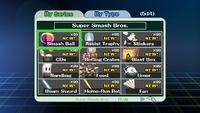
Trophies continue to appear in Super Smash Bros. Brawl. Conceptually, they are unaltered from Melee, but their number was nearly doubled to 544 trophies, with repeat trophies given new 3D models and text. Some unlockables in the game are also gained by collecting enough trophies.
More 'backstory' is provided to trophies in this game: in The Subspace Emissary, the storyline states that fighters who fall in this world in battle are forcibly reverted back to trophies. These trophies of fallen smashers appear as greyed-out, shiny, full-size statues instead of the smaller trophies or statuettes seen in the Trophy Gallery.
In the Trophy Gallery, trophies can be sorted by series (universe), or by type, which has the following categories: Fighter, Fighter Related (most trophies originating from non-Smash universes), Final Smash, Item, Assist Trophy, Poké Ball, The Subspace Emissary, Enemy (Subspace Emissary enemies, bosses, and the Fighting Alloys), Stage (stages and background characters), and Other (trophies from non-fighter universes, such as Animal Crossing, and other trophies).
A new element in the Trophy Gallery is the addition of a small window that displays the console's logo for the game listed, (Donkey Kong Country 2: Diddy's Kong Quest and EarthBound being on the SNES for example) as opposed to the console being written, except for non-Nintendo consoles.
As in the previous game, the trophies can be all collectively viewed at in the Trophy Hoard mode.
Collecting trophies[edit]
Trophies can be obtained through the following means:
- To obtain character trophies, players must finish Classic Mode with that character (one should note that if they play as characters that switch, i.e., Zelda/Sheik, Pokémon Trainer, and Zero Suit Samus/Samus, they only receive a trophy for the character they finished with, and not all characters, requiring more than one playthrough.)
- A trophy of Pokémon Trainer will always be obtained, no matter what character the player ends as, meaning that a player must obtain at least three Pokémon Trainer trophies to get the trophies of all three Pokémon.
- To obtain characters' Final Smash trophies, players must finish All-Star Mode with that character (again, Zelda/Sheik and Samus/Zero Suit Samus' trophies must be collected separately, although Pokémon Trainer's only has one Final Smash trophy to collect)
- Some trophies are only obtainable by beating a Challenge.
- Subspace Army boss and enemy trophies, can only be collected through The Subspace Emissary by fighting an enemy and throwing a Trophy Stand at it when its hit points are critically low in order to capture it as a trophy.
- If the player manages to get a Celebi from a Poké Ball, it will drop some trophies. However, there is only a 1 in 493 chance of encountering Celebi this way.
- Again, in All-Star and Boss Battles modes, trophies will occasionally appear between rounds.
- Added from Melee, a few trophies lie on the Home-Run Contest track and will be automatically picked up by Sandbag if it is hit that far.
- The Trophy Lottery from Melee has been replaced by the Coin Launcher, through which most trophies not specifically limited above can be collected.
Diorama[edit]
This is a feature that is automatically incorporated into Brawl. Accessed from the Trophy Hoard, the player can pick any of the available backgrounds, and follow this up by choosing up to four of their trophies and positioning them against the background. Then, the player can use something similar to the photo menu found in Multiplayer Brawl to position the camera and take a picture, which can be saved to the Wii's internal memory or an SD card.
Gallery[edit]
Artwork of the Trophy Stand in Brawl.
In Super Smash Bros. 4[edit]
Collectible trophies appear in both versions of Super Smash Bros. 4. The Wii U version includes trophies based primarily on home-console games, while the 3DS version primarily focuses on trophies based on handheld games, with the trophy models varying as well.
While the Wii U version of Smash 4 can display up to two games of debut, as well as the system information and date of release, the 3DS version notably lacks this information, due to the smaller screens not giving enough space. Similar to Brawl, the game lists omit non-Nintendo consoles from being displayed, except for "Arcade" released games, like Pac-Man and Street Fighter.
With trophies depicting Ubisoft's Rayman, Globox, and Barbara, as well as Gaijin Games's Commander Video in the Wii U version of Super Smash Bros. 4, the game marks the first time that third-party franchises without a playable character within the game have trophies.
Super Smash Bros. for Nintendo 3DS alone features 685 trophies in the vanilla game and 707 trophies with DLC, while Super Smash Bros. for Wii U features 716 trophies in the vanilla game and 743 trophies with DLC.
While still informing players of the origin and details of trophies, the trophy descriptions in Smash 4 take on a considerably less serious tone than in either Melee or Brawl; trophies can feature puns, jokes, wordplay, references to popular culture, and descriptions that directly address the player. Additionally, most trophies have differently worded descriptions between the NTSC and European versions, whereas most trophies in previous games only had minor differences such as spelling and typos.
A new feature exclusive to Super Smash Bros. for Wii U are Trophy Boxes for displaying collected trophies. These boxes are mostly themed after the source game(s) of what the trophy depicts. Another Wii U exclusive feature is the Photo Studio, an improved version of Brawl's Diorama, in which players can now resize trophies, rotate them in any direction, and remove their stands.
Like in Brawl, trophies can be sorted by series (universe), or by type, which has the following categories: Fighter, Fighter Related (elements that are part of a character's moveset), Final Smash, Item, Assist Trophy, Poké Ball, Enemy (stage bosses and enemies in Smash Run and Smash Tour respectively), Stage (stages and background characters), Series Related (elements belonging to fighter's universes) and Other (trophies from non-fighter universes). Trophies can now be listed by order of which the player obtains them.
Collecting trophies[edit]
Trophies can be obtained by the following means:
- Can appear during a match as long as at least one item is turned on.
- If a player manages to get a Mew from a Poké Ball, it may drop a trophy.
- Can be obtained in Trophy Rush by breaking a trophy block; Certain trophies can only be obtained via this method.
- Can be purchased from the Trophy Shop.
- During Classic Mode, a trophy can be obtained if the roulette stops on a trophy and the player clears the current round.
- In the 3DS version, some paths can contain trophies while on the Wii U version, some characters carry trophies and can be rewarded if the player or any teammates in team battles can defeat them.
- Clearing Classic Mode in either the Wii U and 3DS versions will unlock a trophy of the player's character.
- Clearing All-Star Mode will unlock an Alt. trophy of the player's character on the 3DS version or a Final Smash trophy on the Wii U version.
- Alt trophies can still be obtained on the Wii U version by first clearing Classic Mode with a character, then its Alt trophy can be available exclusively in the trophy shop.
- In All-Star Mode, trophies can appear in the rest area after certain rounds.
- Certain trophies can only be unlocked by completing a challenge.
- By breaking a trophy target in Target Blast, they can get a random trophy at the end of the second round.
- Certain paths in Event Mode contain trophies and can be obtained if the player can unlock that path.
- Like in previous games, they can appear in the Home-Run Contest if the Sandbag can hit it.
- Defeating enemies in Smash Run may cause them to drop trophies.
- Can be obtained in Smash Tour.
- Can be earned by clearing Crazy Orders by breaking certain treasure chests Crazy Hand drops.
- Can be earned by scanning an amiibo after it fought in a match.
- Some trophies are included with the purchase of DLC content. This includes alt. trophies of all DLC characters in the Wii U version.
In Super Smash Bros. Ultimate[edit]
Trophies do not return in Ultimate. Instead, spirits serve as their successor, whose in-game concept is similar to that of the stickers from Brawl. As a result, this makes Ultimate the first Smash Bros. game since the original where trophies do not appear. Like stickers, spirits lack descriptions, with the only information given being what game series the spirit originated from.
The entire concept of fighters originating from toys, while still present, is downplayed and nearly absent from the content of the actual game. As seen in multiple character reveal trailers and one of the bad endings to Adventure Mode: World of Light, characters can die normally and no longer turn into trophies when killed as in The Subspace Emissary. Also unlike previous games, characters' Classic Mode endings do not depict either a trophy or a plush doll landing in the real world. In the November 1, 2018 Nintendo Direct, Masahiro Sakurai re-asserted that the characters exist as toys in the real world, compared to the world of Smash Bros. which is a "world of imagination" where the fighters exist as living beings. The toy bodies exist as a means for the fighters to return to the real world (as seen in the Classic Mode endings of previous games), while spirits are unable to do so because their physical forms have been destroyed.[2] This aspect gets tied into the plot of the game's Adventure mode, where during the Direct it was explicitly stated that Galeem's attack was what destroyed the characters' bodies.
Real-world amiibo for the game still stand on a Trophy Stand, and in World of Light's second opening cutscene, the imprisoned Mario is also depicted atop a Trophy Stand (the only time one can be seen in-game). However, this trophy stand in the cutscene is made out of what appears to be stone rather than gold. This is repeated in Sora's reveal trailer, where the entire revealed cast is depicted as trophies, with their normal golden stands. However, unlike in the previous games, the characters are not in a unique pose as a trophy and simply stand with their arms to their side. Additionally, characters can simply choose to wake up on their own instead of having to be saved by external forces, and when waking up, the trophy base simply dissolves rather than the entire trophy glowing.
Trivia[edit]
- By datamining Super Smash Bros. Brawl, it has been discovered that some of the playable characters had different trophies that were meant to be their main trophy earned from beating Classic Mode with that character, but were taken out and replaced with the ones in the final version of the game. A video of the unused trophies can be seen here.
- Super Smash Bros. Melee is the only game where the playable characters' trophies are not posed like their official renders.
- Several of the trophies in Melee have a reflection of a screenshot of Osohe Castle from the scrapped N64 version of Mother 3.
- Kid Icarus: Uprising, also developed by Masahiro Sakurai, features Idols, a collectible consisting of a 3D model and flavor text, largely identical to trophies, albeit animated.
References[edit]
| Trophies by series | |
|---|---|
| Melee trophies | Mario · Yoshi · Donkey Kong · The Legend of Zelda · F-Zero · Star Fox · Metroid · Kirby · EarthBound · Fire Emblem · Pokémon · Ice Climber · Game & Watch · Others · Super Smash Bros. · (All trophies) |
| Brawl trophies | Super Smash Bros. · The Subspace Emissary · Mario · Donkey Kong · The Legend of Zelda · Metroid · Yoshi · Kirby · Star Fox · Pokémon · F-Zero · EarthBound · Ice Climber · Fire Emblem · Kid Icarus · Wario · Pikmin · Animal Crossing · Game & Watch · Others · Metal Gear · Sonic the Hedgehog · (All trophies) |
| SSB4 trophies | Super Smash Bros. · Mario · Donkey Kong · The Legend of Zelda · Metroid · Yoshi · Kirby · Star Fox · Pokémon · F-Zero · EarthBound · Fire Emblem · Game & Watch · Kid Icarus · Wario · Pikmin · R.O.B. · Animal Crossing · Wii Fit · Punch-Out!! · Xenoblade Chronicles · Duck Hunt · Others · Sonic the Hedgehog · Mega Man · Pac-Man · Street Fighter · Final Fantasy · Bayonetta · (All trophies) |
| Items in Super Smash Bros. Melee | |
|---|---|
| Normal | Barrel Cannon · Beam Sword · Bob-omb · Bunny Hood · Cloaking Device · Fan · Fire Flower · Flipper · Food · Freezie · Green Shell · Hammer · Heart Container · Home-Run Bat · Lip's Stick · Maxim Tomato · Metal Box · Motion-Sensor Bomb · Mr. Saturn · Parasol · Poison Mushroom · Poké Ball · Ray Gun · Red Shell · Screw Attack · Star Rod · Starman · Super Mushroom · Super Scope · Warp Star |
| Containers | Barrel · Capsule · Crate · Egg · Party Ball |
| Other | Smash Coins |
| Items in Super Smash Bros. Brawl | |
|---|---|
| Normal | Assist Trophy · Banana Peel · Beam Sword · Blast Box · Bob-omb · Bumper · Bunny Hood · Cracker Launcher · Deku Nut · Dragoon · Fan · Fire Flower · Food · Franklin Badge · Freezie · Golden Hammer · Gooey Bomb · Green Shell · Hammer · Heart Container · Home-Run Bat · Hothead · Lightning Bolt · Lip's Stick · Maxim Tomato · Metal Box · Motion-Sensor Bomb · Mr. Saturn · Pitfall · Poison Mushroom · Poké Ball · Ray Gun · Screw Attack · Smart Bomb · Smash Ball · Smoke Ball · Soccer Ball · Spring · Star Rod · Starman · Super Mushroom · Super Scope · Superspicy Curry · Team Healer · Timer · Unira · Warp Star |
| Containers | Barrel · Capsule · Crate · Party Ball · Sandbag · Rolling Crates |
| The Subspace Emissary |
Key · Stock Ball · Trophy Stand |
| Collectibles | CD · Coins · Sticker · Trophy |
| Other | Smash Coins and Bills |
| Super Smash Bros. Melee menu items | |
|---|---|
| Vs. Mode | Melee (Time · Stock · Coin Battle · Bonus · Team Battle) · Custom Rules · Special Melee · Tournament Mode · Names |
| 1-P Mode | Regular Match (Classic Mode · All-Star Mode · Adventure Mode) · Event Match · Stadium (Target Test · Home-Run Contest · Multi-Man Melee) · Training |
| Trophies | Gallery · Collection · Lottery |
| Options | Rumble · Sound · Screen Display · Language · Erase Data |
| Data | Snapshots · Melee Records · Sound Test · Archives (NTSC only) · How to Play (PAL only) |
| Unused | Debug menu · Debug sound test menu |
| Super Smash Bros. Brawl menu items | |
|---|---|
| Group | Brawl (Time · Stock · Coin Battle · Team Battle) · Rules · Special Brawl · Rotation · Tourney · Names |
| Solo | Classic · All-Star · Adventure Mode: The Subspace Emissary · Events · Stadium (Target Smash!! · Home-Run Contest · Multi-Man Brawl · Boss Battles) · Training |
| Wi-Fi | Spectator Mode · With Anyone · With Friends |
| Vault | Trophies & Stickers (Trophy Gallery · Trophy Hoard · Coin Launcher · Sticker Album · Sticker Center) · Stage Builder · Album · Challenges · Replays · Masterpieces · Chronicle |
| Options | Screen · Deflicker · Rumble · Controls · Sound · My Music · Erase Data |
| Data | Movies · Records (Group Records · Brawl Records · Notices) · Sound Test |
| Super Smash Bros. for Nintendo 3DS menu items | |
|---|---|
| Smash | Smash (Solo · Group · Time · Stock · Team Battle) · Rules |
| Smash Run | Solo · Group · Custom · Select Music |
| Games & More | Classic · All-Star · Stadium (Multi-Man Smash · Target Blast · Home-Run Contest) · Training · Custom · amiibo · Vault (Trophies · Trophy Rush · Album · Replays · Sounds · Records · Tips) · Options (Controls · Sound · Character Outline · Damage Display · Internet Options) |
| Online | Spectator Mode · With Anyone (For Fun · For Glory) · With Friends · Conquest · Share |
| Other | Challenge · StreetPass · Wii U |
| Super Smash Bros. for Wii U menu items | |
|---|---|
| Smash | Smash (Time · Stock · Coin Battle · Team Battle) · 8-Player Smash · Special Smash · Rules · Controls |
| Games & More | Classic · All-Star · Stadium (Target Blast · Home-Run Contest · Multi-Man Smash) · Training · Events · Special Orders (Master Orders · Crazy Orders) · Custom · Stage Builder · amiibo · Vault (Trophies · Trophy Rush · Album · Replays · Movies · Sounds · Records · Tips · Masterpieces) · Options (Controls · Sound · My Music · Internet Options) |
| Online | Spectator Mode · With Anyone (For Fun · For Glory) · With Friends · Online Events (Tourney · Conquest) · Share |
| Other | Challenge · Smash Tour · 3DS |
